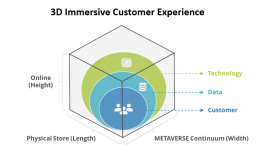The 3 Dimensions of Retail Immersive Customer Experience
“The opportunity with the Metaverse is it creates infinite possibilities for us to connect, create and belong. […] In essence, how can we help our current members, get educated, informed and show them the way?” Tareq Nazlawy – Senior Director Digital, adidas
Despite the internal and external challenges that retailers must face, real-time contextual customer experience is a key factor for retailers and brands that aims to engage, retain and enhance shoppers’ experiences during different and multiple interactions and interfaces.
According to our Global Retail Operating Models 2022 Survey, brick-and-mortar remains retailers’ main channel source of revenue generation over the next two years. At the same time, eCommerce and marketplaces as well as retail media networks, conversational and social commerce are expected to become new and increasing channels of new revenue streams.
This would allow retailers’ operating models to become fully omni-channel while completely integrate online and physical operations, in real-time.
However, the traditional convergence between online and offline is now nowadays characterized by a third dimension that aims to augment the overall shopping experience, including the metaverse continuum. This ranges from AR-enable visual and image search to 3D product visualization, to more sophisticated and immersive virtual realities for visual commerce, such as Web3 and Metaverse platforms and related NFT capabilities.
At the center of this 3D integration – between online, physical stores, and metaverse continuum – there are three core elements that are foundational of the immersive retail customer experience. The core elements are:
- Customers. Shoppers’ need, behaviour and preference as well as the customer-centric approach that permeates B2C, B2B2C and D2C business models.
- Data. Collecting and managing first-, second- and/or third-party, retailers and brands become key players of partners ecosystems for leveraging customer data platforms (CDPs) and customer data sharing hubs to guarantee data accuracy, security and identity management.
- Technology. AR, VR, digital twin, and Metaverse are (re)emerging technologies that fueled by data and powered by AI and ML analytics, enable retailers to enhance personalization of the customer journey model.
As we have recently published in the IDC FutureScape on Worldwide Retail 2023 Preditions, “By 2024, 65% of Retailers Will Invest in Visual Commerce to Enable Personalization Through 3D Product Configuration and Virtual Try-On and Reduce Complexity Through Image-Based Interfaces”.
There are also concrete examples of retailers that launched metaverse initiatives, such as Nike launching on Roblox; Walmart adopting an AR-powered virtual try-on option for in-app virtual fitting from home; recently, LaCoste opened its Web3 community for Le Club loyalty program members or the Swedish retailer H&M is currently piloting a new tech-enabled collection of style (COS) store — including smart mirrors — with the intention to expand this format soon across all its stores.
These are all examples of retailers already investing on visual commerce-enabling technologies enhancing personalization and customer engagement at the highest level of immersion. To achieve this goal, there are some IT implications to consider:
Frame visual search applications with the overall retail commerce platform infrastructure to enrich a solid customer data base (such as customer data platform) for CX personalization.
Integrate AR/VR to the current in-store technologies (e.g., RFID, sensors, and smart mirrors) to achieve a fully omni-channel experience.
Set the basis for metaverse requires overcoming any complexities deriving from existing customer-facing disconnected interfaces.
Key Actions for Retailers
So, what retailers should do then? Here there are three immediate key actions:
- Include augmented commerce as part of business model innovation, and long-term strategic digital road map use case definition.
- Go or become fully and truly omni-channel implementing those capabilities and technologies that bridge personalization to augmented customer experience.
- Co-innovate along retail metaverse continuum with the right partners to generate customer lifetime value across multiple interfaces and – again! – reducing complexities.
IDC Retail Insights analysts Ornella Urso and Filippo Battaini will be onsite in New York for NRF 2023: Retail’s Big Show. They look forward to meeting you and share their research themes and upcoming IDC initiatives for 2023!


